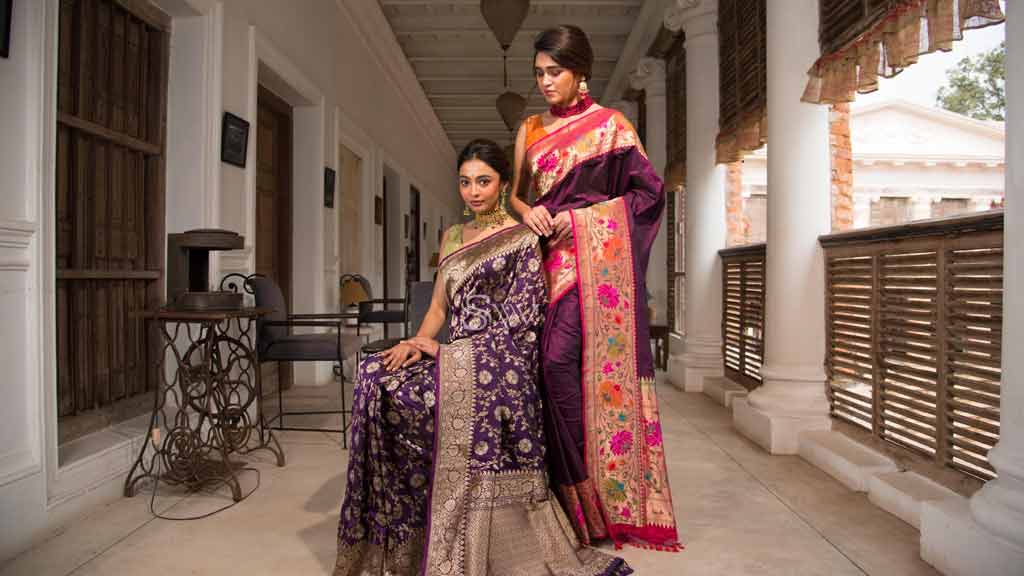Haldi saree is a traditional Indian garment that is commonly worn during haldi ceremonies, which are a part of Indian weddings. These sarees are typically yellow or turmeric-coloured, as they are meant to represent the colour of the haldi paste that is applied to the bride during the pre-wedding ritual. The origin of haldi saree can be traced back to ancient India, where yellow was associated with purity and auspiciousness. Over time, the practice of applying haldi paste to the bride before their wedding ceremony became a popular tradition, and the haldi saree was born to honour this ritual. Haldi saree comes in a variety of styles and materials. The most common fabric used for haldi saree is cotton, as it is comfortable and breathable. However, silk, and other lightweight fabrics can also be used. In terms of style, haldi saree can be plain or embellished with embroidery, sequins, or other decorative elements. The most popular type of haldi saree is the traditional Bengali saree, which features a broad border and a pallu that is draped over the head.
In most cases, haldi saree is yellow or turmeric-coloured. This is important because it symbolizes the haldi paste that is applied during the haldi ceremony. Additionally, the fabric should be lightweight and comfortable, as haldi ceremonies can be quite warm and humid. It is also important to choose a haldi saree that is easy to drape, as the ceremony can be quite hectic and there may not be much time to spend on perfecting the saree’s draping. Finally, it is always a good idea to choose a saree that you feel comfortable and confident in, as this will help you enjoy the ceremony and make the most of the experience.
Pure silk sarees
Pure silk sarees are a traditional Indian garment that has been worn for centuries. These sarees are made of pure silk, which is a luxurious and delicate fabric that gives the saree a unique texture and sheen. Silk is believed to have originated in China more than 5,000 years ago, but it eventually made its way to India and became a popular fabric for sarees. Silk was highly valued in ancient India, and it was often used to make clothes for royalty and nobility. Over time, pure silk sarees became popular with all classes of Indian society, and they are now an essential part of Indian cultural heritage.
There are different types of pure silk sarees, each with its unique characteristics and history. Some of the most popular types of pure silk sarees include:
- Banarasi Silk: Banarasi silk sarees are made in the city of Varanasi in Uttar Pradesh. These pure silk sarees are known for their intricate embroidery, delicate designs, and rich colors.
- Kanchipuram Silk: Kanchipuram silk sarees are made in the town of Kanchipuram in Tamil Nadu. These pure silk sarees are known for their bright colors, bold patterns, and heavy borders.
- Tussar Silk: Tussar silk sarees are made from the cocoon of the Tussar silkworm, which is found in India. These pure silk sarees are known for their natural texture and earthy colors.
- Mysore Silk: Mysore silk sarees are made in the city of Mysore in Karnataka. These pure silk sarees are known for their soft texture and pastel colors.
Pure silk sarees are renowned for their elegance and beauty. The rich, luxurious texture of the fabric, combined with the intricate designs and patterns, creates a stunning and regal look. The drape of a pure silk saree is also unique, with the fabric flowing effortlessly and creating a graceful silhouette. Pure silk sarees are often worn for formal occasions, such as weddings, and they are a symbol of elegance and sophistication. The elegance of pure silk sarees is unmatched, and it is a symbol of beauty, grace, and regalness. Whether worn for a special occasion or just for everyday wear, pure silk sarees are a true testament to the beauty of Indian culture and tradition.


